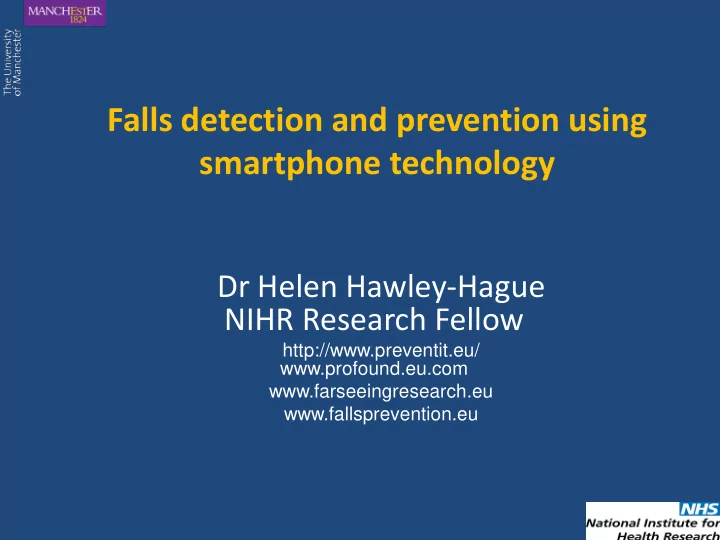

Falls detection and prevention using smartphone technology Dr Helen Hawley-Hague NIHR Research Fellow http://www.preventit.eu/ www.profound.eu.com www.farseeingresearch.eu www.fallsprevention.eu
30-40% community dwelling www.iofbonehealth.org >65yrs fall in year 40-60% no injury 30-50% minor injury 5-6% major injury (excluding fracture) Masud, Morris Age & Ageing 2001; 30-S4 3-7 Rubenstein. Age & Ageing ; 2006; 35-S2; ii37-41 5% fractures 1% hip fractures Falls most serious frequent home accident 50% hospital admissions for injury due to fall History of falls a major predictor future fall
Falls can be prevented! Gillespie et al 2012 159 trials 79193 participants 44 trials 9,603 participants • Multiple-component group exercise – RaR 0.71 [0.63-0.82] RR 0.85 [0.76-0.96] • Multiple-component home-based exercise – RaR 0.68 [0.58-0.80] RR 0.78 [0.64-0.94] RR=0.83 (95%CI 0.75-0.91) • Tai Chi (High Dose & Challenging RR=0.58 (95%CI0.48–0.69) Sherrington et al JAGS 2008 – RaR 0.72 [0.52-1.00] RR 0.71 [0.57-0.87]
Two problems • Adherence • Identification We are not always good We do not always know at implementing the when someone falls or evidence base, older what happens adults do not adhere! beforehand.
FARSEEING EC FP7 project 10 partners I Bologna Florence Milan x 2 UK Manchester D Stuttgart Cologne NO Trondheim x2 CH Lausanne 1.Universita di Bologna 2.BTCINO 3.Servico Sanitario della Toscana 4.NoemaLife 5.Norges Teknisk-Naturvitenskapelige Universitet 6.SINTEF 7.Robert Bosch Krankenhaus 8.Deutsche Sporthochschule Koln 9.EPFL 10.University of Manchester
Real-World Falls Database Defined a data format and build up a meta-database to collect a reasonable number of falls (more than 200). Collect data and signals through the monitoring of high-risk subjects and fit elderly people. Build up a network of experts in this field willing to share knowledge and data. Develop signal processing methods and novel algorithms for the assessment of daily living activities and of health status. Defined an evidence-based fall risk model using advanced data mining and reasoning techniques.
What does it mean for practice? • More accurate detection • Reduction in false alarms • Outside detection • Further understanding of what happens just before someone falls? • Already tested in Italy and Norway.
How smartphone technology can/could help adherence to evidence based exercise
• Estimated population changes will result in fracture rates beyond the reach of current intervention(Benzinger et al., 2015), need innovative ideas! • Soon everyone will have a smartphone! 50% of people aged 55-64 now have one, this has more than doubled since 2012 (Ofcom, 2015) • Older adults prefer existing technology rather than new equipment (Hawley-Hague et al, 2014).
• To assist in delivering exercise Clinical outcomes were found to be as good if not better (Kairy et al. 2009). • Adherence to telerehabilitation is good (Kairy et al. 2009). • Social networks and friendship identified as important aspects of group telerehabilitation programmes (Lai et al., 2004).
S martphone T echnology E xercise in the H ome F easibility trial Can smartphone and teleconferencing technology be used to deliver an effective home exercise intervention to prevent falls amongst community dwelling older people? School of Nursing, Midwifery & Social Work
The Technology
The technology will increase: Exercise Safety Social support Waist case belt used for wearing the smartphone Motivation School of Nursing, Midwifery & Social Work
Project outline Setup Phase Study 1: Usability Steering group Revision Testing Study 2: Phase Creating Feasibility RCT Acceptability and smartphone usability of Reflection applications technology with older 1. Assess feasibility on findings adults/health from of interventions Initial testing professionals. usability delivered as full testing alternative to Working with Three weeks testing standard service. health period with patients Revisions to professionals and staff. applications 2. Assess and set-up feasibility/ PPI workshops - Recording of issues acceptability of - Interviews with design and Preparation patients procedures. for Study 2 - Focus groups with 3 falls services 3. Determine effect sizes for sample- size calculations for definitive large scale RCT. School of Nursing, Midwifery & Social Work
App development • Motivate me • My activity programme With special thanks to Later Life Training for permission to use pictures and name ‘Motivate me’.
Recruitment so far • 7 patients, 4 men and 3 women. • 3 existing wifi, 1 provided wifi, 3 with 4G.
Key lessons so far Patients • They generally like the teleconferencing- varied technical support required. • They like self-reporting and the feedback that they get. • They generally find self-reporting and feedback more motivating than messages on outcomes. • Apps simple to use/some issues with touchscreen.
Key lessons so far Health professionals • Their app could be made more intuitive and more flexible. • Some patients it is just not suitable for 1. Point programme/motivation 2. Cognition 3. Safety • Introducing new exercises.
What next? • More testing • Focus groups with staff • Co-design of feasibility RCT- more than 1 site. • Full multi-site trial. • Motivational and self-report apps could be used within different patient cohorts. • Could be used after group exercise interventions. • What happens after intervention period?
Early risk detection and prevention in ageing people by self-administered ICT-supported assessment and a behavioural change intervention delivered by use of smartphones and smartwatches
PreventIT • Will use smartphone and smartwatches to deliver motivation. • Will deliver an adapted version of Clemson et al’s LiFE programme (Clemson et al, 2012 BMJ). Integrating activities as part of everyday life. • Multi-site feasibility RCT
Ongoing work • Work with Phillips Healthcare exploring the acceptability and potential impact of the use of predictive analytics in the prevention of readmission to hospital for falls. • Work with Tiyga Health and mHealth technologies to assess how self-report data alongside sensor data can aid assessment and intervention for falls.
Acknowledgements Research Team: Health/Social care: Prof Chris Todd Central Manchester Falls team: Prof.David French Bernie O’Dowd Dr Lis Boulton Ellen Martinez Prof Jorunn Helbostad Caroline Birch Prof. Lorenzo Chiari North Manchester Falls Team Dr Sabato Malone Trafford Community Services Dr Carlo Tacconi AgeUK Tameside Dr Helen Hosker Julie Jerram School of Nursing, Midwifery & Social Work
http://profound.eu.com/ Farseeingresearch.eu Preventit.eu Email: Helen.Hawley-Hague@manchester.ac.uk
Recommend
More recommend